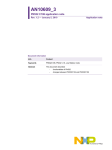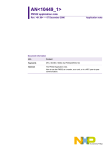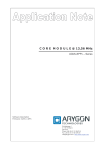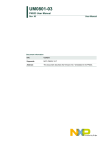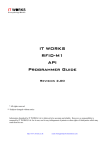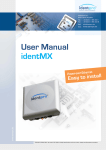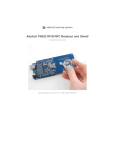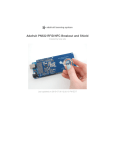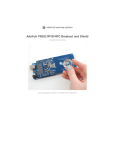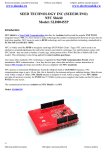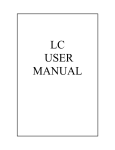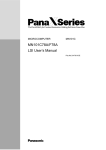Download NFC/RFID R E A D E R M O D U L E @ 13,56 MHz
Transcript
Erthalstrasse 1 D - 55118 Mainz Germany Phone +49 (0) 61 31-30476-0 Fax +49 (0) 61 31-30 476-20 [email protected] • http://www.arygon.com Frequently Asked Questions ARYGON TECHNOLOGIES AG AFAQ Document: Frequently Asked Questions Author: J. Schneider / T. Baur / A. Kretschmann Current Version: 0.5 Date: April 2008 Document history Revision 0.1 0.2 0.3 Date September 2006 October 2006 February 2007 0.4 August 2007 0.5 April 2008 Description First published version I2C behaviour was added § 3.2.2 e) LL-command MxRtyPassiveActivation are described Merged with document “Abstract 0.1” FAQ n) and o) added. RS232 interface a) changed. Contact information For additional information and sales office addresses visit: http://www.arygon.com or http://www.nfc-global.com © All rights reserved. Copyright by Arygon Technologies AG 2007 ARYGON_FREQUENTLY_ASKED_QUESTIONS_AFAQ_05.doc Page 2 of 21 Frequently Asked Questions ARYGON TECHNOLOGIES AG AFAQ Contents 1. Description 2. Conventions and notations 2.1 Abbreviations 2.2 Document information !"#$% ( ) !&' ' ** ' '+ , ( -./ 0 00 !"#$% 1 , 2 '& ( 3 0 1 4 . 4 1 0 1 ( , 6 5 11 7 : /-- -;/ * ( 4 ( /;& 1 % . 4 0 ) ?4 !"#$% % .8> ( 9 , >( /! , 0 !"#$% 1 &1 9 0 + 4 , !"#$% 4 ( 0 1 % 11 B !"#$% !"#$% ( 1 11 9 , 8 (( . 3 !"#$% 0 8 ( + <&= ! , + , + >( ) 0 @0 (A > 6 , 1 (C . 00 ' D 4 , ' ( ** '+ !"#$% ! E. ) , 1 AF .4 */< ( 00 1 < !A4 0 0 1 1 0 ( 4. References ARYGON_FREQUENTLY_ASKED_QUESTIONS_AFAQ_05.doc 5 4 , ( 0 , 1 4 0 4 5 , : ' Page 3 of 21 Frequently Asked Questions ARYGON TECHNOLOGIES AG AFAQ 1. Description About this document This document summarises some questions which we have got from our customers. Get in contact with us if you have any further questions or ideas in order to improve our support. 2. Conventions and notations 2.1 Abbreviations ACMA APPA RM SMX p2p NFC PN531 TAMA NA PICC API IDE VCP ARYGON Core Module Version A ARYGON Plug and Play Module Version A Reader Module SmartMX peer to peer (passive, active) Near Field Communication Philips Reader-IC Philips Reader-IC, nickname for PN53x Not applicable Mifare® proximity card Application Programming Interface Integrated Development Environment Virtual com port 2.2 Document information Info Content Keywords Abstract MIFARE®, NFC, PN531 This document describes the Frequently Asked Questions. ARYGON_FREQUENTLY_ASKED_QUESTIONS_AFAQ_05.doc Page 4 of 21 Frequently Asked Questions ARYGON TECHNOLOGIES AG AFAQ )* * #! $ + !"# $% ! ,&- .. * */ 0 !! #!& ! '( $ $ # Some PC hardware and software "dislike" floating levels on their open RS232 Com Port pins. To avoid problems the null modem principle is strongly recommended. Otherwise many unnecessary interrupts (level CTS, DSR or RI) can occur. If a user wants to connect the RS232 reader direct to a standard PC, the following wiring should be considered. Nullmodem principle with Nullmodem cable: PC (Host) SubD male Nullmodem Wire 2 x SubD female 1 DCD 2 RX 3 TX 4 DTR 6 DSR 5 GND 7 RTS 8 CTS 9 RI Reader SubD male 1 DCD 2 RX 3 TX 4 DTR 6 DSR 5 GND 7 RTS 8 CTS 9 RI Reader Pins RX TX GND Nullmodem principle with Straight Through cable: PC (Host) SubD male 1 DCD 2 RX 3 TX 4 DTR 6 DSR 5 GND 7 RTS 8 CTS 9 RI Extension Cable female to male Reader SubD female 1 DCD 2 RX 3 TX 4 DTR 6 DSR 5 GND 7 RTS 8 CTS 9 RI ARYGON_FREQUENTLY_ASKED_QUESTIONS_AFAQ_05.doc Reader Pins RX TX GND Page 5 of 21 Frequently Asked Questions ARYGON TECHNOLOGIES AG AFAQ 1 " # 2 ""#13 2 ! $ 0 4" '( #+ $ $ $5 43 " $ Yes, of course, but you have to add an additional circuit. The user I/O ports supply only a current of max. 15mA. Therefore an additional amplification is necessary to get a minimum current of 1A. Example of an I/O port amplifier schematic e.g.: 8…12V ~ / 1A Vcc (5V) Door opener Relais: Pri. DC: 5V / 56 Ohm Sec.: 50…230V / 1…2A Self induction recuperation diode Arygon Reader ACMA or APPA I/O Port (TTL-Pegel) 5V/15mA. R = 330 R = 100 # % ! 6#! 4" Noise suppresion Relais NPN e.g.: BC547 + # 0 #"23 7"422 $" 90mA '( $ $5 43 ! As hardware interface we use 9 pins to the Samsung KS0066 or HD44780 display controllers or compatible. - 4-bit bi-directional data bus. - 3 control lines. - 2 pins for power supply (+5V and GND). All those pins are provided by the ARYGON reader module. It supports 2 x 20 or 2 x 40 characters. The command sets are in ASCII command as well. Get in touch with us to get the document ANSW_Display_10.pdf ARYGON_FREQUENTLY_ASKED_QUESTIONS_AFAQ_05.doc Page 6 of 21 Frequently Asked Questions ARYGON TECHNOLOGIES AG AFAQ '& ( # 2$ 35 " $ #3 13 " " #! $ + - ARYGON distinguishes between two languages: - ARYGON high level language - TAMA low level language The availability of languages depends on the mounting of the printed circuit board. Therefore you have to make a difference between “µC equipped” and “no µC equipped”. The availability of the µC is mandatory in case of: Stand-alone applications like access control. Wiegand™ interface. Party line applications (RS485 / RS422 / I2C). High level language usage in any terminal program (for easier testing). High level language usage in Mifare® applications where checksum handling is not required or not possible because of host limitations. Personalization of the Reader. Only with µC equipped it is possible to store the Mifare® authentication keys into the Reader (µC EEPROM). TAMA provides no user EEPROM. Storing the NFC Open Identifier data. DES / 3DES encryption/decryption for Desfire Tags or for NFC peer to peer communications with ciphering. More than two user GPIO pins needed for extra digital switching or digital read functions. (TAMA offers two user GPIOs, µC offers 9 user GPIOs, a PWM output pins and an analog input pin.) Standard LCD interface needed. Performing a TAMA hardware reset via a software command from host to µC. Protocol modes (µC equipped) Several protocol modes are supported via a mode select command byte which is sent as first Byte in every data packet from host to the µC. The mode select command byte tells the equipped µC how the following bytes have to be interpreted. The mode select command byte is always sent in ASCII format. Following mode select command Bytes are available: '0' High level language in ASCII format. (Common µC commands and Mifare® commands) '1' High level language in Binary format with addressing byte for party line. (Common µC commands and Mifare® commands) '2' Philips protocol (TAMA language) in binary format. '3' Philips protocol (TAMA language) in binary with addressing byte for party line. ARYGON_FREQUENTLY_ASKED_QUESTIONS_AFAQ_05.doc Page 7 of 21 Frequently Asked Questions ARYGON TECHNOLOGIES AG AFAQ 1 ! 7 4" %5 '( #& 3 3 3 !&4 & 55 ! " 0 Commands for adjustments and special µC-functions are always started with letter 'a'. Common µC commands (auxiliary commands) 'ah' 'at' 'ar' 'au' 'av' 'asn' 'as' 'asl' 'apc' 'apw' 'apr' 'apm' 'apa' 'ali' 'alo' 'aer' 'aew' 'aek' ‘aec’ 'aep' 'aen' 'aes' 'aeg' 'apl' Set UART baud rate to host side. Set UART baud rate to TAMA side. Initiate a TAMA hardware reset. Initiate a µC software reset. Get µC firmware version. Get the unique serial number of the reader. TAMA RFRegulation test. Power down mode (sleep). Configuration of the GPIO pins. Write GPIO. Read GPIO. Set PWM output duty cycle. Read analog port input value. Internal µC EEPROM login to modify EEPROM data. Internal µC EEPROM logout. Read one Byte from the internal µC EEPROM. Write one Byte into the internal µC EEPROM. Write a Mifare® login keytype with key into the internal µC EEPROM. Check appropriate EEPROM Mifare® key location if it is used. Write a new PIN code for internal µC EEPROM write access. Write a new PIN code for internal µC EEPROM NFC open identifier area. Write (set) one block of data into the NFC open identifier area. Read (get) one block of data from the NFC open identifier area. Party line (RS4XX) polling command. ISO 14443-A / Mifare commands 's' 'l' 'r' 'wb' 'w4' 'rv' 'wv' '+' '-' '=' 'h' 'of' 'p' Select a single card/tag Login (authenticate) Read data block/page on a tag Write data block/page (16 Byte) Write data block/page (4 Byte) for Mifare® ultralight tags Read value block Write/format value block Increment value block Decrement value block Copy value block Set tag into halt RF Configuration (switch off antenna) Polling for tags with autonomous periodic wake up from sleep mode. (= Select a single card with reduced power consumption). ARYGON_FREQUENTLY_ASKED_QUESTIONS_AFAQ_05.doc Page 8 of 21 Frequently Asked Questions ARYGON TECHNOLOGIES AG AFAQ 9 " 3 PC -> RM 0 s " "#!&3 $ "2 !" 2 $ &: 0 6 5 ! #! " + #& 83 3 55 ! //0 = mode 0; s=select a single card/tag) RM -> PC FF0000 16 4B 01 01 04 00 08 04 32EEED2E Case: Mifare® standard 1k: FF0000: Status, refer to µC response packet. 16: User data length (number of character in Hex). 4B: TAMA InListPassiveTarget Response packet. 01: Number of initialized targets. 01: Target Number 0400: SENS_RES = Answer to request 08: SEL_RES (card Type) (08 = Mifare® standard) = answer to select 04: Card ID (NFCID1) length. 32EEED2E: Card ID (NFCID1). (Refer to PN531 User Manual) Case: Mifare® Ultralight FF0000: Status, refer to µC response packet. 1E: User data length (number of character in Hex). 4B: TAMA InListPassiveTarget response packet. 01: Number of initialized targets. 01: Target number 4400: SENS_RES 00: SEL_RES (card Typ) (00 = Mifare® UltraLight) 08: Card ID (NFCID1) length. 8804686211127A00: Card ID (NFCID1). Case: Mifare® standard 4k FF0000: Status, refer to µC response packet. 16: User data length (number of character in Hex). 4B: TAMA InListPassiveTarget response packet. 01: Number of initialized targets. 01: Target number 0200: SENS_RES 18: SEL_RES (card Typ) (18 = Mifare® 4k) 04: Card ID (NFCID1) length. 56347400: Card ID (NFCID1). ARYGON_FREQUENTLY_ASKED_QUESTIONS_AFAQ_05.doc Page 9 of 21 Frequently Asked Questions ARYGON TECHNOLOGIES AG AFAQ % 0 ! "%# ! ++ ! '( "6 2 $ $ Our LEDs are no power LED. They are controlled by the user application with the ARYGON high-level language. LED commands: Set the I/O LED Ports to output (only once): 0 a p c 0 2 0 0 // red LED 0 a p c 0 6 0 0 // green LED Switch LED to on: 0 a p w 0 2 0 1 0 a p w 0 6 0 1 // red LED // green LED Switch LED to off: 0 a p w 0 2 0 0 0 a p w 0 6 0 0 // red LED // green LED Refer to ANSW-ACMA-APPA-xx.pdf for more info about the reader command set. " $ $ . + $ '( $ $5 43 " #3 13 0 No. The reader protocol can be considered as an “open interface” protocol. You have the possibility to write your own application without reservations or limitations. An API or DLL is not needed as you can communicate with the reader modules by using the Com port support of your IDE. + # $ # $ "0 $ " $ #3 13 + $ '( "6 2 $ $ $ ); The USB interface of ARYGON reader modules can be accessed via the virtual com port (VCP) or direct driver support (USBExpress) of the following operating systems. - Windows 98 SE/2000/XP/Vista - Linux 2.4 or later (Please read the txt-file ..\SOFTWARE\SiLabs_CP210xDriverInstall\LINUX\NOTE_LINUX_DRIVER.txt - Macintosh OS - WindowsCE More Information of our used USB to UART converter IC: http://www.silabs.com & ! $ ) #$ $ " %# '( $ $5 43 "0 Yes, a new firmware version with integrated ARYGON High Level DESFire command set including 3DES decryption is now available (Beta Version). Ask for our new DESFire application Note: ANSW-DESFire-xx.pdf. ARYGON_FREQUENTLY_ASKED_QUESTIONS_AFAQ_05.doc Page 10 of 21 Frequently Asked Questions ARYGON TECHNOLOGIES AG AFAQ " 57 ! 13 2 ! ,&, #$4 3 $ 5 14 '( <2 !"% $ : " %$ !&0 6# $) 5"4!& #+ $ $ $ #+ $ 6 "!: $ "2 ! The reader sends automatically the first command of ISO14443 when the card indicates it supports it. Consequently, after “select a single card/tag” command, the NFC enabled phone is in ISO14443-4 mode, and doesn't understand anymore Mifare command. The problem is just on the reader side, you must send the TAMA low-level command SetTAMAParameters. Indeed, the NFC enabled phone is able to communicate either in mifare mode or in ISO14443-4 mode. (bit 5 of the SEL_RES = 0x28 means ISO14443-4 support, as defined in ISO14443-4 standard specification). So, on the reader side, if you want to communicate in mifare mode, you have to disable the automatic selection of ISO14443-4: // low level language PC -> RM: SET TAMA PARAMETERS 00 00 FF 03 FD D4 12 04 16 00 RM -> PC: ACK 00 00 FF 00 FF 00 RM -> PC: SET TAMA PARAMETERS EXECUTED 00 00 FF 02 FE D5 13 18 00 Default mode (ISO14443-4): PC -> RM: INITIATOR: 0s // µC Select a single Card 106 kBaud Card FF 00 00 00 // Response - OK! RM -> PC RM -> PC FF 00 00 30 4B 01 01 04 00 28 04 30 44 1C 80 0D 78 80 80 02 00 73 C8 40 00 00 90 00 // Response NFC enabled Phone Mifare mode: // low level language PC -> RM: SET TAMA PARAMETERS 00 00 FF 03 FD D4 12 04 16 00 RM -> PC: ACK 00 00 FF 00 FF 00 RM -> PC: SET TAMA PARAMETERS EXECUTED 00 00 FF 02 FE D5 13 18 00 // High Level in ASCII PC -> RM: INITIATOR: 0s // µC Select a single Card 106 kBaud card RM -> PC FF 00 00 00 // Response - OK! RM -> PC FF 00 00 16 4B 01 01 04 00 28 04 F0 E1 1C 80 // Response of the NFC enabled phone ARYGON_FREQUENTLY_ASKED_QUESTIONS_AFAQ_05.doc Page 11 of 21 Frequently Asked Questions ARYGON TECHNOLOGIES AG AFAQ # # #+ $ 3 !&4 & 0 55 ! " $ #3 13 #! " += 3 %83 3 Mifare command set PCD (TAMA) Command set supported by TAMA PICC_REQIDL PICC_REQALL PICC_ANTICOLL1 PICC_ANTICOLL11 PICC_ANTICOLL12 PICC_ANTICOLL13 PICC_ANTICOLL2 PICC_ANTICOLL3 0x26 0x52 0x93 0x92 0x94 0x98 0x95 0x97 TAMA only intern TAMA only intern TAMA only intern TAMA only intern TAMA only intern TAMA only intern TAMA only intern TAMA only intern ->The command 4A 01 00 (InListPassiveTarget) masks the commands mentioned before. PICC_AUTHENT1A 0x60 40 01 60 15 FF FF FF FF FF FF 82 63 58 32 PICC_AUTHENT1B 0x61 40 01 61 20 FF FF FF FF FF BB F2 07 EE 2E PICC_READ16 0x30 40 01 30 15 PICC_WRITE16 0xA0 40 01 A0 20 01 02 03 04 05 06 07 08 09 0A 0B 0C 0D 0F 10 11 PICC_WRITE4 0xA2 40 01 A2 21 01 02 03 04 PICC_DECREMENT 0xC0 40 01 C0 21 04 00 00 00; PICC_INCREMENT 0xC1 40 01 C1 21 04 00 00 00; // PICC_RESTORE 0xC2 40 01 C2 15; PICC_TRANSFER 0xB0 40 01 B0 16; PICC_HALT 0x50 44 01; TAMA InDeselect command RF off 32 01 00; (Refer to PN531 User Manual) In case of Increment, Decrement or Restore (copy), there is a combination with command TRANSFER necessary. > " $ " 4$ @4#22 A #3 13 0 + $ 3 2#!& %# 5 4! #!& + ?! 4 Yes, following you find our source code for building the TAMA command frames. ARYGON_FREQUENTLY_ASKED_QUESTIONS_AFAQ_05.doc Page 12 of 21 ARYGON TECHNOLOGIES AG Frequently Asked Questions AFAQ Building of frame structure from host (µC) to TAMA (refer to PN531 User Manual): // info begin typedef struct { uchar ptr; // read/write pointer uchar buff[BUFLENGTH2]; } rxstruct; typedef struct { uchar anz_data; // 0 = empty, buflength = full uchar rd_ptr; // read pointer uchar wr_ptr; // write pointer uchar buff[BUFLENGTH]; } rngbuffstruct; // for rng_wr_txbuf1 // info end void build_tama_frame(rxstruct *buff) { uchar checks, anz, i; /* folgend: uchar Typecast => autom. int erweiterung verhindern */ /* EasyCODE - */ anz = buff->ptr + 1; rng_wr_txbuf1(0x00); // preamble rng_wr_txbuf1(0x00); // start code rng_wr_txbuf1(0xFF); // start code rng_wr_txbuf1(anz); // LEN rng_wr_txbuf1(((uchar)-anz)); // LEN checksum rng_wr_txbuf1(0xD4); // TFI (from Host to TAMA) checks = 0xD4; for (i = 0; i < (buff->ptr); i++) { rng_wr_txbuf1(buff->buff[i]); checks += buff->buff[i]; } rng_wr_txbuf1(((uchar)-checks)); // packet data checksum rng_wr_txbuf1(0x00); // postamble TX1IE = 1; } ARYGON_FREQUENTLY_ASKED_QUESTIONS_AFAQ_05.doc Page 13 of 21 ARYGON TECHNOLOGIES AG Frequently Asked Questions AFAQ TAMA frame check, after receiving a TAMA response: uchar tama_checks(rxstruct *buff) /* Reponse: TRUE: Checksum – ok! FALSE: Checksum – wrong (packet length or packet data) */ { uchar checks ,i; /* following: uchar Typecast => autom. int enhancement are prohibited */ if (buff->buff[3] != 0) { if (buff->buff[4] != ((uchar)-buff->buff[3])) { // packet length checks wrong return FALSE; } checks = 0; for (i = 0; i < buff->buff[3]; i++) { checks += buff->buff[i+5]; } if (( buff->buff[buff->buff[3] + 5] ) != ((uchar)-checks)) { // packet data checks wrong return FALSE; } if (buff->buff[5] == 0x7F) { error1 = 9; } } else { // Tama ack packet } return TRUE; } ARYGON_FREQUENTLY_ASKED_QUESTIONS_AFAQ_05.doc Page 14 of 21 Frequently Asked Questions ARYGON TECHNOLOGIES AG AFAQ 6 # B ,&- .. */ !"# 0 $#! " + !! #!& ! '( $ At the beginning it should be mentioned that TAMA is not comparable with an I2C EEPROM! 1.) As first, according the I2C specification accidentally bit changes because of EMC influence are not allowed. The complete circuit must ensure that all lines are kept very short (max. 10cm ) and that they are absolutely stabled and protected. I2C is not comparable with UART or RS232 / RS485 or USB because line buses are tolerant for bit interferences I2C absolutely not ! In I2C environment all devices can hang if for example the ACK bit, Start or stop condition will fail. 2.) We have observed that sometimes the TAMA I2C ACK Bit is missing but this is allowed! If the polling read command is sent to fast to the TAMA and the TAMA is busy, then it happens that the TAMA sends no ACK bit. According to I2C specification: "When a slave doesn’t acknowledge the slave address (for example, it’s unable to receive or transmit because it’s performing some real-time function), the data line must be left HIGH by the slave. The master can then generate either a STOP condition to abort the transfer, or a repeated START condition to start a new transfer." In order to understand the behaviour, please read the following investigation. We use a PC I2C Test tool, we are sending to the TAMA the command, get Firmware Version: 00 00 FF 02 FE D4 02 2A 00 With an oscilloscope we have traced the following pins: - Yellow: TAMA SCL. - Green: TAMA SDA. - Magenta: Test point on your interface board = direction of SDA low means: TAMA can send or host wants to sent high high means: host wants to send low) 48 00 00 FF 02 FE D4 02 2A 00 49 (TAMA I2C ACK Bit is missing here) Delay of about 13ms. 49 01 TAMA ACK packet TAMA response packet It seems all is OK. ARYGON_FREQUENTLY_ASKED_QUESTIONS_AFAQ_05.doc Page 15 of 21 ARYGON TECHNOLOGIES AG Frequently Asked Questions AFAQ After every Data Byte the TAMA sends the I2C ACK bit (low) to the PC – It’s OK. 0x49 is the Read command is OK (first polling) But the TAMA does not set the I2C ACK bit (low) after receiving of the first 0x49. Then the PC Tool does not activate the CLOCK (SCL), then the TAMA doesn’t send the status Byte with RDY = 0x00 The ACK bit is missing: Because of the fact that the PC Tool does ignore this problem, sometimes the packet flow continues. ARYGON_FREQUENTLY_ASKED_QUESTIONS_AFAQ_05.doc Page 16 of 21 ARYGON TECHNOLOGIES AG Frequently Asked Questions AFAQ Then about 10...20ms later the PC Tool activates the SCL (clock). And now we see a correct I2C ACK bit (low) from the TAMA. And now we see the correct Status Byte 0x01 = RDY from the TAMA. And the packet flow is continued. The above behaviour is no bug, it is according to I2C specification. 3). Sometimes it happens that the TAMA will pull down the SCL line and The I2C host is blocked (hangs). This is allowed we found out and according I2C specification. According to I2C specification: "If a Slave device cannot handle incoming data until it has performed some other function, it can hold SCL low to force the Master into a wait-state." Conclusion: If you consider all these facts I2C works. For testing we have programmed our µC with I2C interface for TAMA I2C testing and we have no problem any more. ARYGON_FREQUENTLY_ASKED_QUESTIONS_AFAQ_05.doc Page 17 of 21 Frequently Asked Questions ARYGON TECHNOLOGIES AG AFAQ 3 ! %# 3 %83 3 55 ! MxRtyPassiveActivation0 If a function is necessary to get directly a response”Card detected – YES / NO”, in this case you can send a low-level command MxRtyPassiveActivation : Step 1 PC -> RM: MxRtyPassiveActivation 00 00 FF 06 FA D4 32 05 FF 00 02 F4 00 // 0x02 = 3 times MxRtyPassiveActivation = 0x00 is not possible. Step 2 PC -> RM: INITIATOR: 0s RM -> PC FF 00 00 00 // µC Select a single Card 106 kBaud card // Response - OK! Card detected: RM -> PC FF 00 00 16 4B 01 01 04 00 08 04 64 FD 6B 36 No Card detected: RM -> PC FF 00 00 16 4B 00 5 % ! 4" //Response – tag detected! // Response – tag isn’t detected! =C . $5 - " #" "422 $ 0 Yes, the PN53x reader family supports the ISO14443-4 (T=CL) protocol. Also called wrapped ISO7816 APDU frame. All normal processor based cards uses this ISO14443-4 (T=CL) protocol. The PN531 has a limitation according the loaddata length but this problem is solved in the PN532 (Short APDU frames are supported). ! !1 2 6 1 6 $ 0 $ " ! #+ " ! $ #" $5 43 2 ! #!& ! " ! " " 3 1" 34 ! =1 4 This can happen if you are using a variant equipped with ARYGON Controller and PN531 or PN532. Then if you have selected different baud rates between host to ARYGON controller and ARYGON Controller to TAMA. Condition: The TAMA (PN531 or PN532) is running with 115,2 kBaud (PN532 starts always with 115,2 kBaud as default). To be downwards compatible to our existing reader modules with the PN531 our µC provides to the host still 9600Baud. But to the TAMA side we have now always 115,2kBaud as default. Also the RSTPDN Pin have we to invert in case of PN532. Mifare cards and other cards commands works, and our controller has no problem with different baud rate conversion from in normal cases (short TAMA frames). So far OK. ARYGON_FREQUENTLY_ASKED_QUESTIONS_AFAQ_05.doc Page 18 of 21 Frequently Asked Questions ARYGON TECHNOLOGIES AG AFAQ But if we start NFC peer to peer communication with a packet size near to 256 Byte, we receive no ACK packet from the tama and the other side receives always and reproducible the NFC protocol error 00 00 FF 03 FD D5 41 13 D7 00 ! Reason for this: According both documents (TAMA User Manual for the PN531 and PN532) on chapter "Data Link Level" there you find the following possible reasons for a not send Ack packet from the tama to the host: LCS Error, DCS error, Framing error or Timeout in case of UART (HSU): To save time and to avoid having one protocol frame buffer handling more in the system, after our ARYGON controller receives the first byte with 9600 Baud, we send directly this byte with 115,2 kBaud to the TAMA (In case of peer to peer communication we loop through all commands). Then we wait for the next byte coming with 9600 Baud from the host, then we send again this byte immediately to the TAMA and so on..... The consequence is, that we need about 20ms more time as calculated and checked by the TAMA in case of 115,2 kBaud. If we exceed the time interval corresponding of four times the duration of a 256 Byte length frame with the current baud rate used then the TAMA sends nothing to the host (to our controller in case of our Reader modules). That is exactly the case if we have 9600 Baud to the host side and 115,2 kBaud to the TAMA side. Work around: That means our module equipped with ARYGON Controller and the PN532 can not exchanged without any additional manipulating of the baud rates ! The surest method will be to switch via the ARYGON high level language the TAMA baud rate to the same value as the ARYGON controller has to the host side. Then NFC peer to peer will work. This is valid for modules equipped with ARYGON Controller and PN531 or PN532 with UART interface. In case of reader modules with ARYGON Controller with I2C host interface, it should be checked that the host I2C Clock is near to 100 kbit/s (kHz). 7#" % ! #" # ! ! 13 0 % 6 42 "" $ 7 ! " 6 2 $ + $ $ 5 43 %# $ $#!+ $ 5 # ! ! % 6 42 ! " 6 The TAMA wake up handshake mechanism is enabled or disabled by a boot config resistor. This boot config resistor is mounted or not depending on the order information Y or N (refer to the datasheets). If the wake up handshake is enabled, then a module with TAMA only will not work if the host does not support the additional wake up handshake lines IRQ Interrupt Request and HReq Host Request. That is the reason why this appears in the order information in module variants without ARYGON µC. With ARYGON µC equipped the Host wake up handshake is always enabled an can be used. With ARYGON µC equipped the module works also if the host does not support the additional wake up handshake. That means with ARYGON µC equipped the order info Y/N is not relevant because it works in all cases without the need of hardware changes. ARYGON_FREQUENTLY_ASKED_QUESTIONS_AFAQ_05.doc Page 19 of 21 ARYGON TECHNOLOGIES AG Frequently Asked Questions AFAQ Necessity of the wake up handshake: The sense of the wake up handshake is to wake up the host and the reader module synchronized. If the TAMA wake up source RF Level detector is on, then the TAMA can be waken up if an external RF Field is detected. Normally the TAMA wants then to send immediately the NFC Response packet to the host in this case. But if the host is at sleep, then some bits of the first Response byte will be lost because the host clock is off. To avoid this if wake up handshake is enabled the TAMA warn the host via IRQ line that a response packet is available. The host will awaken if IRQ is connected to a host interrupt Input pin. First after the Host is awaken and does an acknowledge via HReq, the TAMA will send the stored response. But if wake up handshake is enabled via the boot config resistor, the TAMA will never send the first NFC response to the host without acknowledge via HReq ! Wake up handshake is necessary if both, host and TAMA, wants to go into sleep mode and the TAMA will be awaken by an external RF Field first and wants to wake up the host. The TAMA sleep command works independent of the wake up handshake mechanism. That means if only the host wants to set the TAMA into and out of the sleep mode, then the wake up handshake mechanism not mandatory. ARYGON_FREQUENTLY_ASKED_QUESTIONS_AFAQ_05.doc Page 20 of 21 ARYGON TECHNOLOGIES AG Frequently Asked Questions AFAQ 4. References PN531 User Manual Hardware Application Note, ANSW-ACMA-XX Software Application Note, ANSW-ACMA-APPA-XX ARYGON_FREQUENTLY_ASKED_QUESTIONS_AFAQ_05.doc Page 21 of 21





















